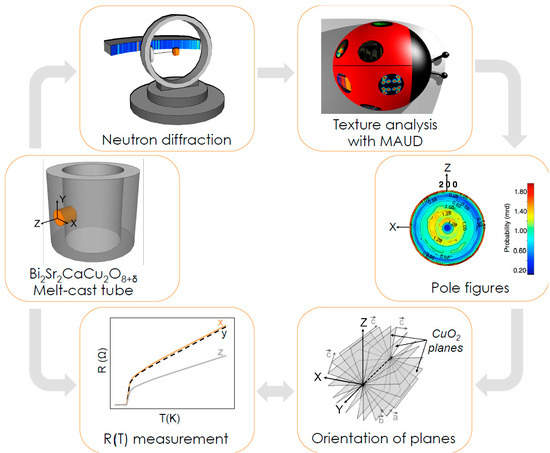Preferred Orientation Contribution to the Anisotropic Normal State Resistivity in Superconducting Melt-Cast Processed Bi2Sr2CaCu2O8+δ
Abstract
:1. Introduction
2. Materials and Methods
2.1. OD-Weighted Resistivity Simulations
2.2. Experimental
3. Results
3.1. Microstructure and Texture Characteristics
3.2. Electrical Resistivity
3.3. Modeling the Resistivity
4. Discussion
4.1. Texture Development in MCP Bi-2212
4.2. Resistivity and Its Anisotropy-Possible Reasons for Discrepancy between the Experiment and Model Calculations
5. Conclusions
Acknowledgments
Author Contributions
Conflicts of Interest
Appendix A
References
- Watanabe, T.; Fujii, T.; Matsuda, A. Anisotropic Resistivities of Precisely Oxygen Controlled Single-Crystal Bi2Sr2CaCu2O8+δ: Systematic Study on “Spin Gap” Effect. Phys. Rev. Lett. 1997, 79, 2113–2116. [Google Scholar] [CrossRef]
- Chen, X.H.; Yu, M.; Ruan, K.Q.; Li, S.Y.; Gui, Z.; Zhang, G.C.; Cao, L.Z. Anisotropic resistivities of single-crystal Bi2Sr2CaCu2O8+δ with different oxygen content. Phys. Rev. B 1998, 58, 14219–14222. [Google Scholar] [CrossRef]
- Hilgenkamp, H.; Mannhart, J. Grain boundaries in high-Tc superconductors. Rev. Mod. Phys. 2002, 74, 485–549. [Google Scholar] [CrossRef]
- Mori, Z.; Doi, T.; Kawabata, D.; Ogata, K.; Takahashi, K.; Matsumoto, A.; Kitaguchi, H.; Hakuraku, Y. Growth of bi-axially textured Bi2Sr2Ca1Cu2O8+δ (2212) thin films on SrTiO3 substrate by sputtering method. Physica C 2008, 468, 1060–1063. [Google Scholar] [CrossRef]
- Dimos, D.; Chaudhari, P.; Mannhart, J.; LeGoues, F.K. Orientation Dependence of Grain-Boundary Critical Currents in YBa2Cu3O7–δ Bicrystals. Phys. Rev. Lett. 1988, 61, 219–222. [Google Scholar] [CrossRef] [PubMed]
- Larbalestier, D.; Gurevich, A.; Feldmann, D.M.; Polyanskii, A. High-Tc superconducting materials for electric power applications. Nature 2001, 414, 368–377. [Google Scholar] [CrossRef] [PubMed]
- Bock, J.; Dommerque, R.; Elschner, S.; Hobl, A.; Rikel, M.O. In Proceedings of the PASREG’10 (2010), Washington, DC, USA, 29 July 2010.
- Garnier, V.; Caillard, R.; Sotelo, A.; Desgardin, G. Relationship among synthesis, microstructure and properties in sinter-forged Bi-2212 ceramics. Physica C 1999, 319, 197–208. [Google Scholar] [CrossRef]
- Pavard, S.; Bourgault, D.; Villard, C.; Tournier, R. Critical current density of 165 kA/cm2 at 4 K in bulk Bi2212/MgO textured by solidification in a high magnetic field and hot forging. Physica C 1999, 316, 198–204. [Google Scholar] [CrossRef]
- Voigt, W. Lehrbuch der Kristallphysik (Mit Ausschluss der Kristalloptik); B.G. Teubner: Berlin, Germany, 1928; ISBN 978-3-663-15884-4. [Google Scholar]
- Reuss, A. Berechnung der Fließgrenze von Mischkristallen auf Grund der Plastizitätsbedingung für Einkristalle. Z. Angew. Math. Mech. 1929, 9, 49–58. [Google Scholar] [CrossRef]
- Matthies, S.; Humbert, M. On the principle of a geometric mean of even-rank symmetric tensors for textured polycrystals. J. Appl. Crystallogr. 1995, 28, 254–266. [Google Scholar] [CrossRef]
- Bock, J.; Bludau, M.; Dommerque, R.; Hobl, A.; Kraemer, S.; Rikel, M.O.; Elschner, S. HTS Fault Current Limiters-First Commercial Devices for Distribution Level Grids in Europe. IEEE Trans. Appl. Supercond. 2011, 21, 1202–1205. [Google Scholar] [CrossRef]
- Fagnard, J.F.; Elschner, S.; Bock, J.; Dirickx, M.; Vanderheyden, B.; Vanderbemden, P. Shielding efficiency and E(J) characteristics measured on large melt cast Bi-2212 hollow cylinders in axial magnetic fields. Supercond. Sci. Technol. 2010, 23, 095012. [Google Scholar] [CrossRef]
- Schweizer, T.; Müller, R.; Bohac, P.; Gauckler, L.J. Oxygen nonstoichiometry of Bi-2212 high-Tc superconductors. In Third Euro-Ceramics, Vol. 2: Properties of Ceramics; Duran, P., Fernandez, J.F., Eds.; Faenza Editrice Iberica: Arganda del Hey, Spain, 1993; Volume 2, pp. 611–616. ISBN 8487683053. [Google Scholar]
- Chateigner, D. Combined Analysis; Wiley-ISTE: London, UK, 2010; ISBN 978-1-84821-198-8. [Google Scholar]
- Lutterotti, L. Total pattern fitting for the combined size–strain–stress–texture determination in thin film diffraction. Nucl. Instrum. Methods Phys. Res. Sect. B 2010, 268, 334–340. [Google Scholar] [CrossRef]
- Gražulis, S.; Chateigner, D.; Downs, R.T.; Yokochi, A.F.T.; Quirós, M.; Lutterotti, L.; Manakova, E.; Butkus, J.; Moeck, P.; Le Bail, A. Crystallography Open Database—An open-access collection of crystal structures. J. Appl. Crystallogr. 2009, 42, 726–729. [Google Scholar] [CrossRef] [PubMed]
- Yamada, Y.; Watanabe, T.; Suzuki, M. Systematic transport properties and their doping dependences for Bi2Sr2CaCu2O8+δ single crystals in a wide doping range. Physica C 2007, 460, 815–816. [Google Scholar] [CrossRef]
- Kumar, J.; Sharma, D.; Ahluwalia, P.K.; Awana, V.P.S. Enhanced superconducting performance of melt quenched Bi2Sr2CaCu2O8 (Bi-2212) superconductor. Mater. Chem. Phys. 2013, 139, 681–688. [Google Scholar] [CrossRef]
- Sotelo, A.; Rasekh, S.; Constantinescu, G.; Amaveda, H.; Torres, M.A.; Madre, M.A.; Diez, J.C. Effect of Pb doping on the electrical properties of textured Bi-2212 superconductors. J. Eur. Ceram. Soc. 2014, 34, 2977–2982. [Google Scholar] [CrossRef]
- Allgeier, C.; Schilling, J.S. Correlation between the magnitude of the superconducting transition temperature and the normal-state magnetic susceptibility in Bi2Sr2CaCu2O8+y and Ti2Ba2CuO6+y as a function of oxygen content. Physica C 1990, 168, 499–505. [Google Scholar] [CrossRef]
- Jean, F.; Collin, G.; Andrieux, M.; Blanchard, N.; Marucco, J.F. Oxygen nonstoichiometry, point defects and critical temperature in superconducting oxide Bi2Sr2CaCu2O8+Δ. Physica C 2000, 339, 269–280. [Google Scholar] [CrossRef]
- Matsubara, I.; Funahashi, R.; Yamashita, H. Growth of Bi-based superconducting whiskers from glass precursors. In Superconducting Glass Ceramics in Bi-Sr-Ca-Cu-O Fabrication and Its Application; Abe, Y., Ed.; World Scientific: Nagoya, Japan, 1997; pp. 149–191. ISBN 978-981-02-3204-7. [Google Scholar]
- Kametani, F.; Jiang, J.; Matras, M.; Abraimov, D.; Hellstrom, E.E.; Larbalestier, D.C. Comparison of grain texture in round Bi2212 and flat Bi2223 superconducting wires and its relation to high critical current densities. Sci. Rep. 2015, 5, 8285. [Google Scholar] [CrossRef] [PubMed]
- Yamashita, S.; Kasai, T.; Fujii, T.; Watanabe, T.; Matsuda, A. Control of carrier concentration in Bi-2212. Physica C 2010, 470 (Suppl. 1), S170–S172. [Google Scholar] [CrossRef]
- Rikel, M.O.; Koliotassis, L.; Ehrenberg, J.; Abdoulaeva, Z.; Hobl, A. Interplay between the Effects of Cation Composition and O Contents on the Physical Properties And lattice Parameters of Melt Cast Processed Bi-2212 Bulk Materials, Report to EUCARD2; EDMS No. 1458872; CERN: Geneva, Switzerland, 2015. [Google Scholar]
- Makise, T.; Uchida, S.; Horii, S.; Shimoyama, J.; Kishio, K. Magnetic properties of Bi2212 single crystals with Bi:Sr:Ca:Cu = 2:2:1:2. Physica C 2007, 460, 772–773. [Google Scholar] [CrossRef]
- Elschner, S.; Bock, J.; Bestgen, H. Influence of granularity on the critical current density in melt-cast processed Bi2Sr2CaCu2Ox. Supercond. Sci. Technol. 1993, 6, 413–420. [Google Scholar] [CrossRef]
- Kametani, F.; Jiang, J.; Polyanskii, A.; Hellstrom, E.E.; Larbalestier, D.C. Grain Structure and Current Transport in Bi2212 Polycrystalline Samples. In Proceedings of the MRS Spring Meeting, San Francisco, CA, USA, 9–13 April 2012. [Google Scholar]
- Bunge, H.J.; Esling, C. Quantitative Texture Analysis; DGM: Oberursel, Germany, 1982; ISBN 3-88355-032-9. [Google Scholar]
- Kocks, U.F.; Tomé, C.N.; Wenk, H.R. Texture and Anisotropy: Preferred Orientations in Polycrystals and Their Effect on Materials Properties; Cambridge University Press: Cambridge, UK, 2000; ISBN 978-0-521-79420-6. [Google Scholar]

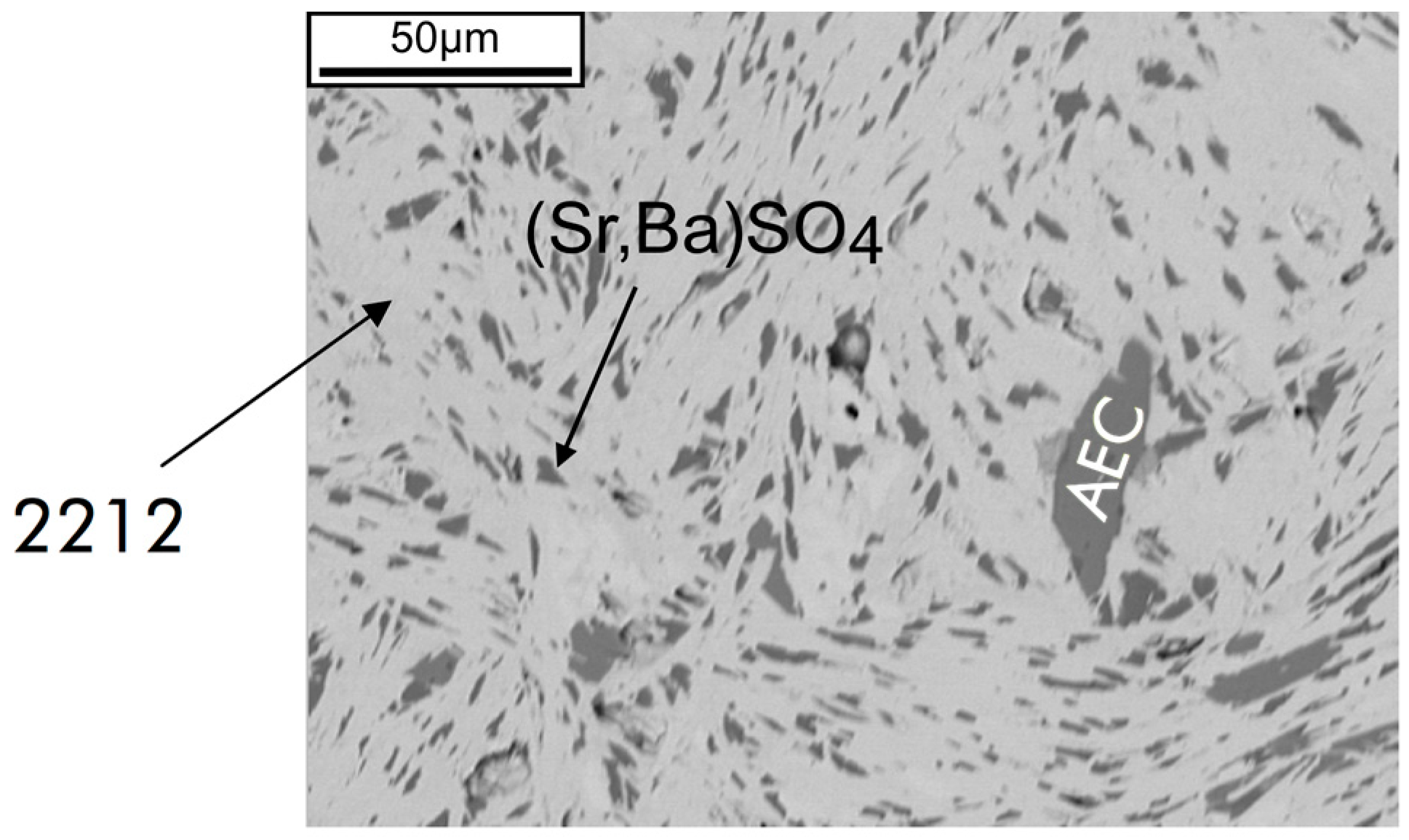
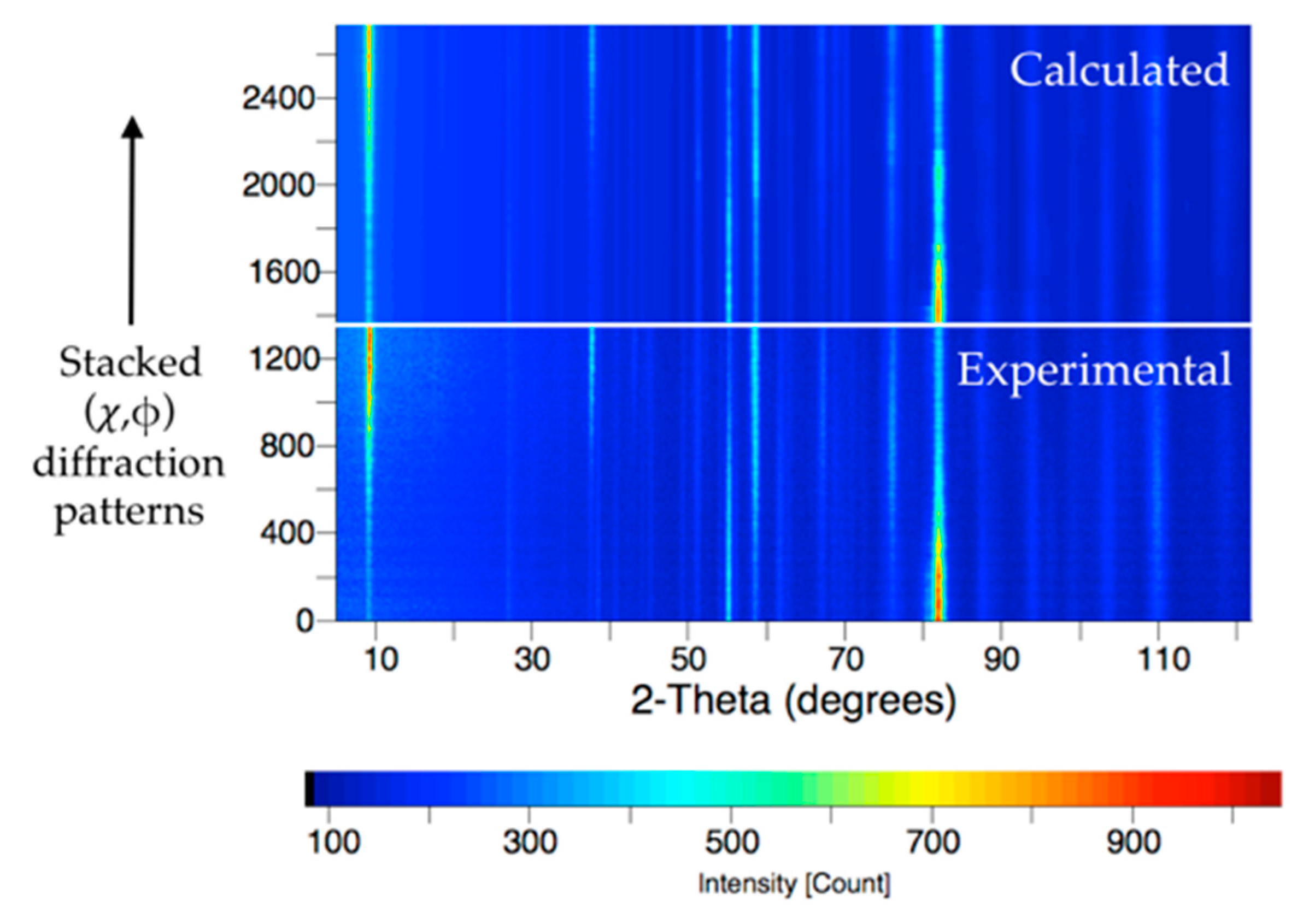
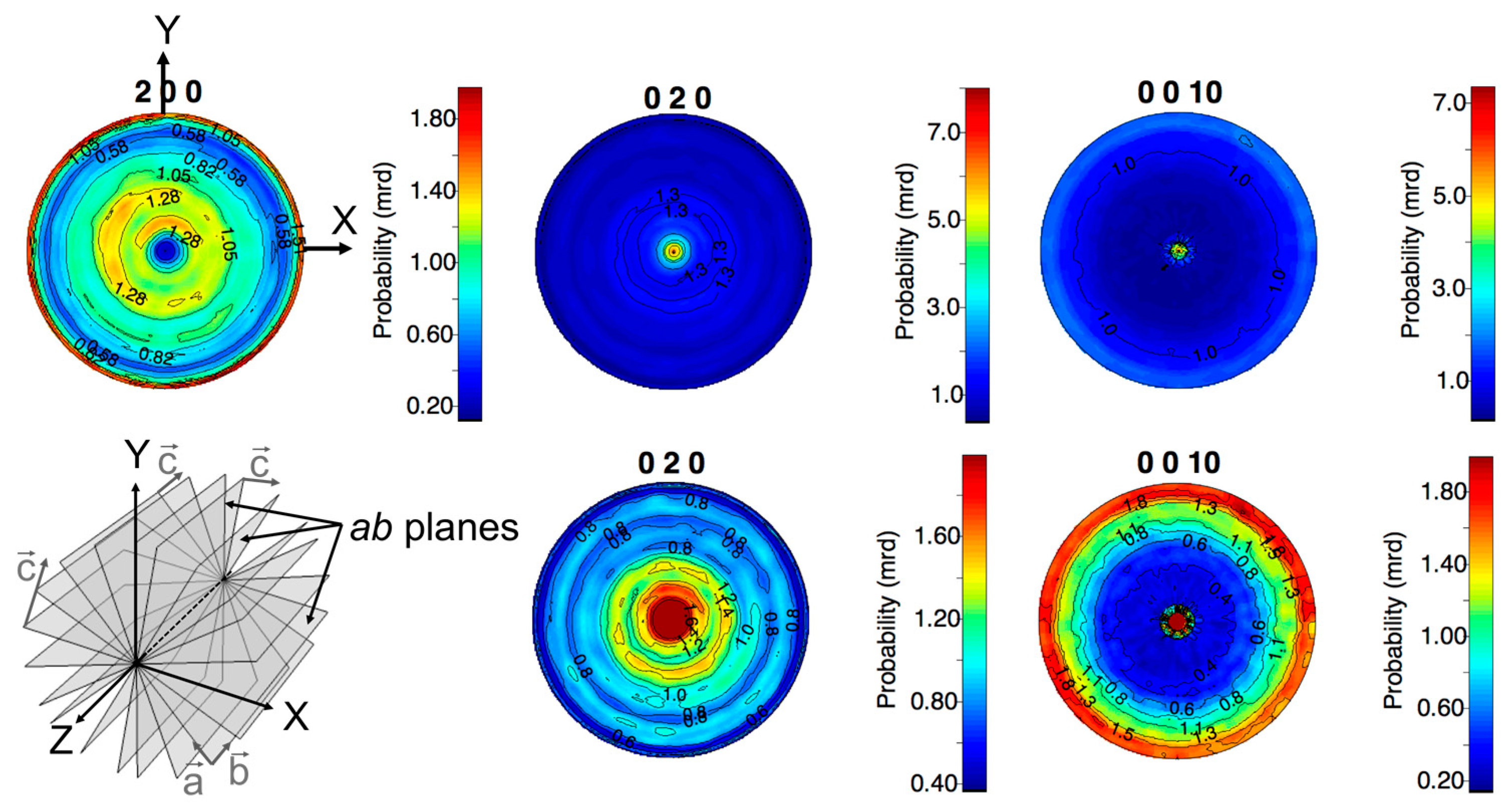

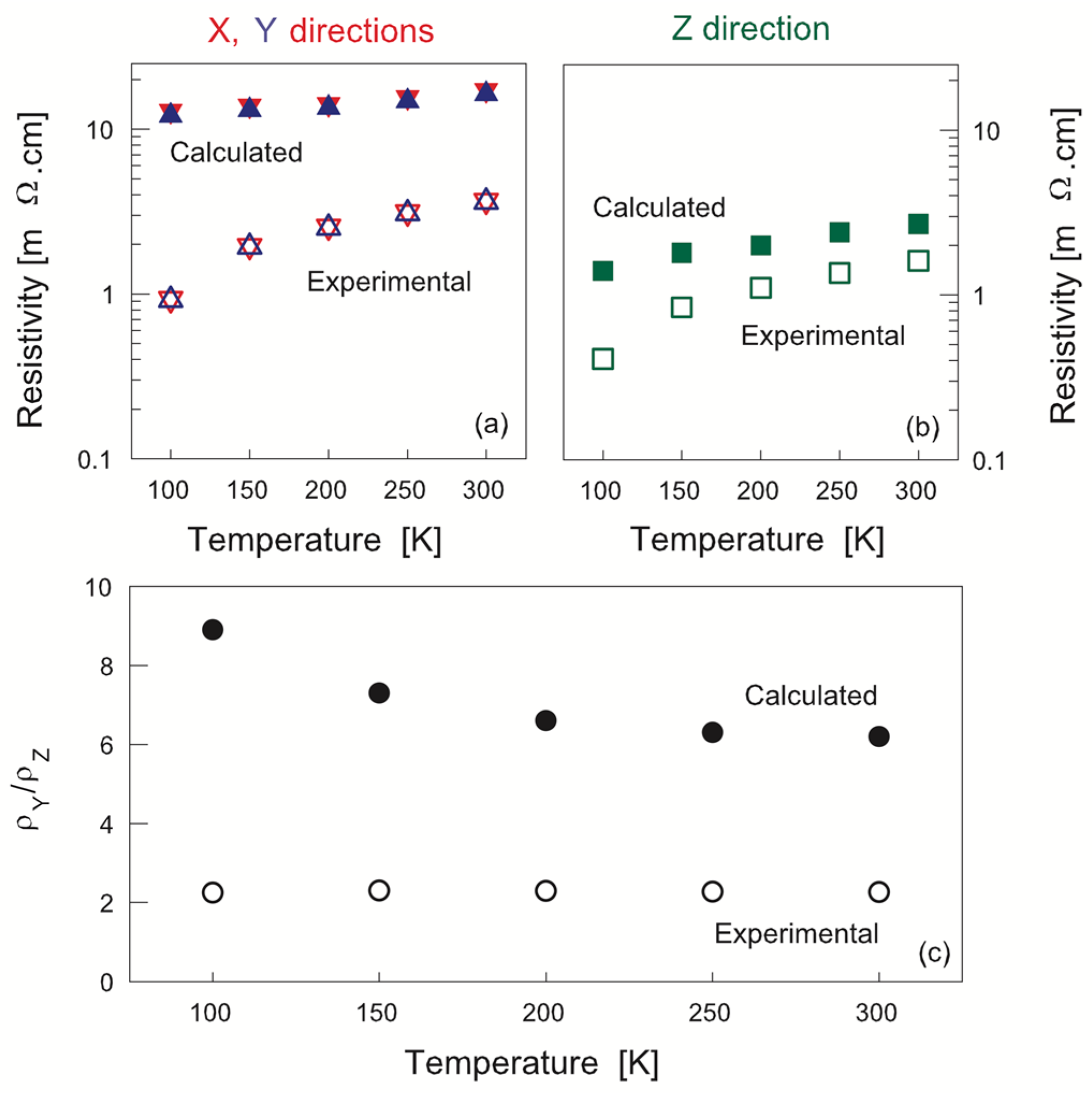
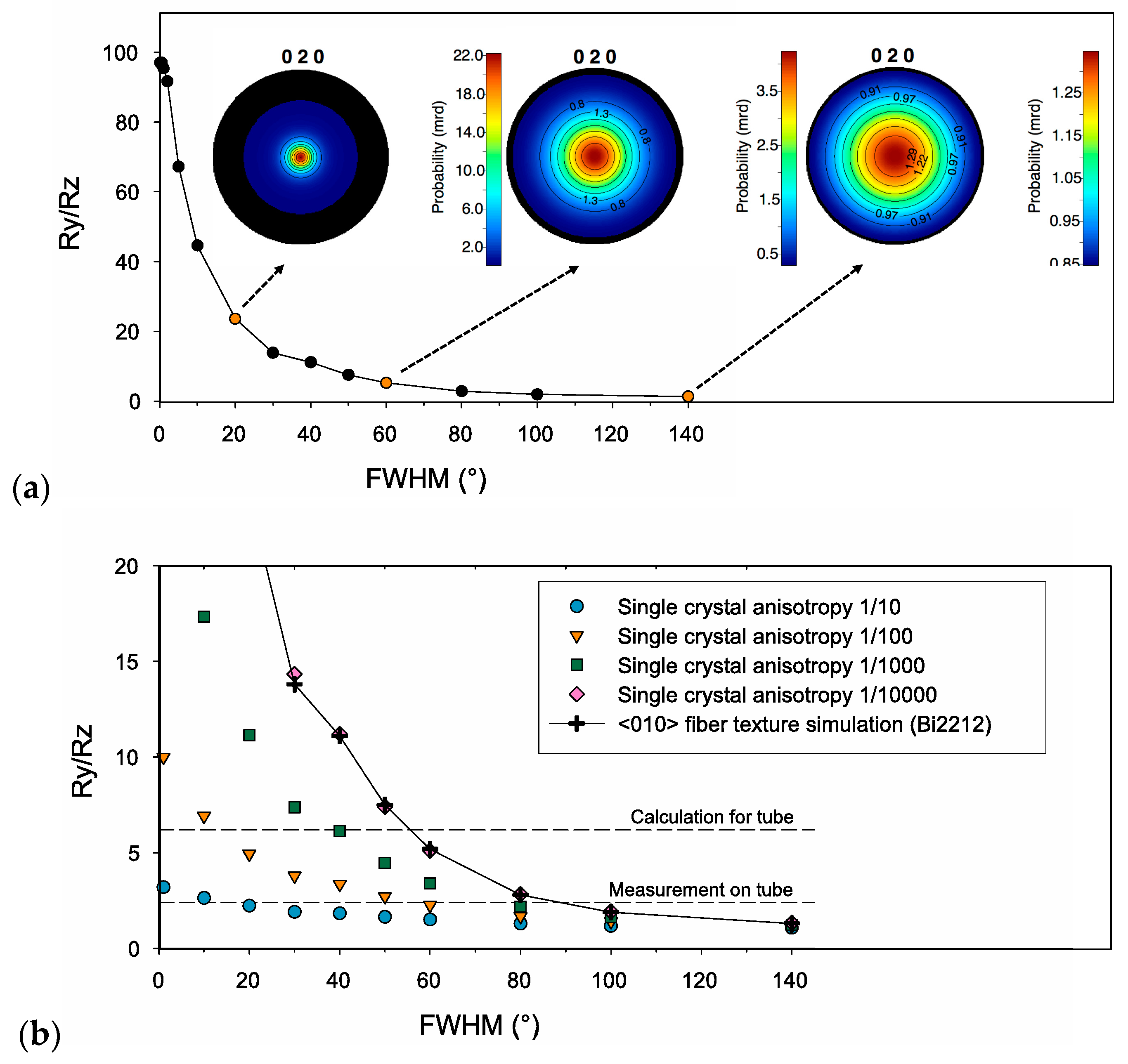
© 2017 by the authors. Licensee MDPI, Basel, Switzerland. This article is an open access article distributed under the terms and conditions of the Creative Commons Attribution (CC BY) license (http://creativecommons.org/licenses/by/4.0/).
Share and Cite
Dellicour, A.; Vertruyen, B.; Rikel, M.O.; Lutterotti, L.; Pautrat, A.; Ouladdiaf, B.; Chateigner, D. Preferred Orientation Contribution to the Anisotropic Normal State Resistivity in Superconducting Melt-Cast Processed Bi2Sr2CaCu2O8+δ. Materials 2017, 10, 534. https://doi.org/10.3390/ma10050534
Dellicour A, Vertruyen B, Rikel MO, Lutterotti L, Pautrat A, Ouladdiaf B, Chateigner D. Preferred Orientation Contribution to the Anisotropic Normal State Resistivity in Superconducting Melt-Cast Processed Bi2Sr2CaCu2O8+δ. Materials. 2017; 10(5):534. https://doi.org/10.3390/ma10050534
Chicago/Turabian StyleDellicour, Aline, Benedicte Vertruyen, Mark O. Rikel, Luca Lutterotti, Alain Pautrat, Bachir Ouladdiaf, and Daniel Chateigner. 2017. "Preferred Orientation Contribution to the Anisotropic Normal State Resistivity in Superconducting Melt-Cast Processed Bi2Sr2CaCu2O8+δ" Materials 10, no. 5: 534. https://doi.org/10.3390/ma10050534






